Photographs: Adnan Abidi/Reuters
Rediff.com takes a look at some of the events that made 2009 memorable, for the right and wrong reasons, and which left an indelible mark on India's collective opinion and imagination.
The award for the comeback performance of the year undoubtedly goes to the 125-year-old grand old party of Indian politics. The Congress stunned naysayers, crushed the opposition Bharatiya Janata Party and silenced its errant allies with its decisive victory in the Lok Sabha polls.
The party won 206 seats across the nation, 61 more than its tally in the 2004 polls, while the BJP won only 116 seats, 22 short of its earlier tally.
The BJP had no dearth of issues to bombard the ruling alliance -- it pounced on every chance to highlight the relentless terror strikes and spiraling prices. BJP's prime ministerial candidate L K Advani termed Manmohan Singh as the 'weakest PM' in every election speech -- a strategy that flopped magnificently, much like the NDA's disastrous 'India Shining' campaign in 2004.
He might not be much of a politician, but most Indians consider Dr Singh as an educated, honest and likeable premier. In the times of disappearing jobs and the economic meltdown, many thought the veteran economist was their best bet.
Many analysts pointed out that the mandate was not so much for the Congress-led alliance, but against the BJP-led National Democratic Alliance. The Congress didn't win for its achievements or governance -- it won because the much-hyped 'young India' identified more with the PM's stoic leadership and the Gandhi family's carefully built up squeaky clean, moderate image than the rigid, right-wing stance of the BJP.
The Lok Sabha polls also altered political equations across the country. The Left Front bit the dust, falling from 61 seats in the 2004 polls to 24 seats in 2009, while Mamata Banerjee-led Trinamool Congress milked public discontent over Singur and Nandigram successfully and won 19 seats -- bettering its performance in 2004 by a whopping 17 seats.
Some regional parties like the All India Anna Dravida Munnetra Kazhagam, Samajwadi Party and the Janata Dal-Secular were humbled. While the Ramvilas Paswan-led Lok Janshakti Party failed to win a single seat, Lalu Yadav-led Rashtriya Janata Dal - which had picked up a fight with the Congress just before the LS polls over the distribution of seats -- won only three seats.
The Congress victory wagon rolls on
Image: Congress supporters celebrate outside their party office in MumbaiPhotographs: Punit Paranjpe/Reuters
In an impressive show, the Congress bagged four out of the five states, which went to polls this year.
In Maharashtra, the Congress-Nationalist Congress Party combine ruling for the past ten years beat the anti-incumbency factor and clung to power, getting 144 seats in a House of 288.
The opposition Shiv Sena-Bharatiya Janata Party combine, already weakened by infighting, was dealt a body blow by the Maharashtra Navnirman Sena, which managed to secure 13 seats in its maiden state elections. The elections also heralded Raj Thackeray and his brand of petty parochialism as a force to reckon with.
A similar success story for the Congress played out in Andhra Pradesh, where the Congress rode back to power for a second consecutive term under the leadership of charismatic Chief Minister Y S Rajasekhara Reddy.
Warding off the onslaught of the four-party Grand Alliance led by Telugu Desam Party and nipping the challenge from the Praja Rajyam Party floated by Telugu megastar Chiranjeevi, YSR managed to secure a simple majority in the 294-member assembly.
The ruling Sikkim Democratic Front staged a spectacular victory by winning all 32 assembly seats in the state, as SDF president and chief minister Pawan Kumar Chamling returned to office for a fourth term.
The Congress continued its winning streak in Arunachal Pradesh, nailing a two third-majority in the 60-member assembly, as Chief Minister Dorjee Khandu and all the members of his cabinet returned to power triumphantly for a second term.
However, Congress' victory ride received a jolt in Haryana, where it failed to get a simple majority in the 90-member house. Though Chief Minister Bhupinder Singh Hooda managed to cobble up a coalition to reach the magic number, he had to prove his majority in the assembly via a trust vote within a week of taking office.
BJP on self-destructive mode
Image: BJP senior leader L K Advani and the deserted party office in Delhi after the LS poll resultsPhotographs: Adnan Abidi/Reuters
The plot began to unravel for the BJP, the main opposition party in India, after its spectacular debacle in the 2009 Lok Sabha polls.
As the party held meetings and prepared reports to dissect its disastrous performance, dissent brewing within the party threatened to tear it apart, as the pro and anti-Hindutva factions openly castigated each other.
The crisis deepened when former finance minister and vice president Yashwant Sinha resigned from all party posts and hit out at the leadership, saying, "In the BJP, we put a premium on failure".
Senior leader Jaswant Singh became the next casualty of the intra-party war when he was expelled by the party for eulogising Jinnah and criticising Jawaharlal Nehru and Sardar Vallabhbhai Patel in his book Jinnah - India, Partition, Independence.
Soon after Jaswant's expulsion, Advani's close aide Sudheendra Kulkarni announced that he was quitting the party because of ideological differences with it. Kulkarni had been associated with the BJP for 13 years as a party activist and political advisor.
Incidentally, while Singh had boldly demanded parity between 'inam' (reward) and 'parinaam' (result), in a stinging article in a magazine, Kulkarni blamed Hindutva and the party's proximity to the Rashtriya Swayamsevak Sangh for its defeat.
Adding to the party's woes, senior leader Arun Shourie raised the banner of revolt against the beleaguered leadership by demanding that the RSS take over the party and change its top brass lock, stock and barrel. He also infamously branded party chief Rajnath Singh as 'Alice in Blunderland'.
India, Dalai, Arunachal on China's crib list
Image: A signboard on the Indian side of the Line of Actual Control along the Indo-China border at ArunchalPhotographs: Adnan Abidi/Reuters
This year, China almost managed to do what no other neighbouring nation has done so far, dislodge Pakistan as India's enemy no 1.
It started with a slew of anti-India articles in the Chinese media, claiming New Delhi was insecure about China and its achievements. A national poll indicated that 90 per cent of the Chinese think that India poses the biggest threat to its existence.
The Indian media didn't mice words while hitting back. A much-publicised article in a reputed defence magazine predicted that a desperate Beijing will launch an attack on India before 2012 to ensure Chinese supremacy in Asia.
A nervous China protested India's 'massive troop deployment' along the Arunachal Pradesh border, while the Centre tried to downplay reports about Chinese incursions in the north-east and Ladakh.
The tensions between the two countries escalated when China protested against Prime Minister Manmohan Singh's October visit to Arunchal Pradesh, which it claims as part of its territory, and then cribbed about the visit of Buddhist spiritual leader Dalai Lama in November.
The relations between the two nations took a turn for the worst when it was revealed that China had started issuing separate visas for residents of Jammu and Kashmir, perceived as the Asian major's attempt to needle India over the 'disputed status' of the state. An exasperated India refused to recognise such visas, and accused China of aiding the Maoist movement by supplying arms to the insurgents.
United States President Barack Obama's attempts to cool down the simmering tension, during his visit to China in November, backfired when the US-China joint statement declared its 'intention to promote peace, stability and development in South Asia'.
An irked Indian administration perceived it as an attempt to interfere in the bilateral relations between India and Pakistan, and caustically stated, "A third country role cannot be envisaged nor is it necessary".
26/11 aftermath: Confessions, lies and accusations
Image: People light candles at a vigil to commemorate the victims of the 26/11 attack and (inset) KasabPhotographs: Rupak De Chowdhuri/Reuters
A year after the most audacious terror strike in India paralysed Mumbai and stunned the world, heroes and villains of the 26/11 attacks continued to hog the headlines.
The trial of Amir Ajmal Kasab, the prime accused in the Mumbai terror attacks case, started in a special court on April 15.
The trial was delayed as the court was unable to find a lawyer to represent Kasab, the sole surviving terrorist held during the terror siege, as the legal community was wary of the outrage and backlash from the public.
Kasab, who appeared unperturbed and indifferent during the course of the trial, initially pleaded not guilty to the many charges against him.
In a complete U-turn on July 30, Kasab pleaded guilty to the charges against him. He also narrated the entire sequence of events that took place during the terror siege, which claimed 183 lives.
Two days later, he dramatically urged the court to hang him, saying, "I don't want to be punished by God. Please punish me by hanging".
But a bigger surprise was in store for the court and the prosecution when Kasab, during his first deposition before the court on December 18, claimed that the police had arrested him 20 days before the 26/11 attacks.
It was his look-alike who had fired indiscriminately at the Chhatrapati Shivaji Terminus on that fateful night, claimed Kasab, adding that the police had arrested him while he was taking a walk at Girgaum Chowpatty.
The reverberations of 26/11 attacks were heard halfway across the world when the Federal Bureau of Investigation arrested Lashkar-e-Tayiba operatives David Headley and Tahawwur Hussain Rana from Chicago in early October for planning terror strikes in India and Denmark.
Investigations revealed that Headley, a Pakistan-born American citizen, had actively helped in planning the Mumbai terror strike, by conducting a reconnaissance of the likely targets for the attack.
Meanwhile, an ugly war of words broke out between the wives of the top cops slain in the 26/11 attack, and the top echelon of the Mumbai police. Kavita Karkare, wife of Anti-Terrorism Squad chief Hemant Karkare, claimed that the police had refused to divulge the circumstances of her husband's death.
Vinita Kamte, wife of Additional Commissioner Ashok Kamte, claimed that Joint Commissioner of Police Rakesh Maria had lied about details of her husband's death, and ignored his pleas for back-up during the terror attack.
Adding fuel to the fire, then Mumbai police commissioner Hasan Gafoor stated, "A section of senior police officers refused to be on the ground and take on the terrorists. By doing so, they chose to ignore the need of the hour."
The fear-less factor
Image: Home Minister P Chidambaram poses with security personnel at Satpal post of the India-Pak borderPhotographs: Vinay Joshi/Reuters
2008 was a year of terror and bloodshed. As a weekly magazine summed up in its year-ending edition, 'fear' was the word that defined last year.
After a spell of terror strikes in major cities across the country -- Delhi, Jaipur, Ahmedabad, Guwahati, Bengaluru, Mumbai -- Indians started 2009 with fear in their hearts and their fingers crossed.
Intelligence agencies kept on making dark prophecies about terror plots being planned by extremists across India, and the metropolitan cities were often put on high alert, but 2009 remained largely a terror-free year, barring stray incidents of blasts in the strife-torn regions of Jammu and Kashmir and northeast.
The Centre, which had been caught napping earlier, finally woke up after the 60-hour terror siege in Mumbai. Revamping the police force, implementing long-pending police reforms, providing better security gear and most importantly, pumping in more funds to equip and upgrade security forces were some of the steps taken in the aftermath of 26/11.
The National Investigative Agency, which can probe terror strikes in any part of the country, became a reality. Newly-ordained Home Minister P Chidambaram also announced his plans to set up National Security Guard hubs or an equivalent commando force in every state.
In a landmark statement, he recently sought a bifurcation of the home ministry to create an internal security ministry, to maintain law and order within India, collate intelligence on terrorism and prevent future terror strikes.
He also promised the setting up of a National Counter Terrorism Centre, which will exclusively deal with counter-terrorism.
The home minister also informed that 12 to 13 terror attacks were neutralised in 2009 by security forces with better intelligence.
But the home minister warned, "Sooner than you think, there may be catastrophe like the Mumbai terror attacks. Hence, the time to act is now and I would spell the last word with capitals NOW."
Who brought down the Babri?
Image: Protestors burn the effigies of BJP leaders, indicted by the Liberhan Commission Report, in KolkataPhotographs: Reuters
Seventeen years after he started an inquiry into the destruction of Ram Janma Bhoomi-Babri Masjid structure at Ayodhya on December 6, 1992, former Madras high court chief justice M S Liberhan officially stated what everyone had always suspected anyway -- that leaders of the BJP and the Sangh Parivar were responsible for the demolition.
In its nearly 1,000-page report, the Liberhan Commission indicted several top BJP leaders including Atal Bihari Vajpayee, L K Advani, Murli Manohar Joshi and then Uttar Pradesh chief minister Kalyan Singh, for leading the country to the 'brink of communal discord' over the Ayodhya issue.
The commission held that the 'pseudo-moderate' leadership of the BJP -- Vajpayee, Advani and Joshi -- was party to the decisions of the Sangh Parivaar to demolish the 16th century structure in Ayodhya.
The Centre was forced to table the report in the Parliament after its contents were leaked and published in a prominent daily. The BJP accused the government of deliberately leaking the report and called its findings 'idiotic'.
During the ensuing debate, the Parliament had to be adjourned quite a few times as the heated exchanges between the Treasury and the Opposition benches escalated.
While the Congress said that former prime minister P V Narsimha Rao had made a 'bad political judgment' in the matter, it gave a clean chit to the ailing Vajpayee, saying, "Vajpayee's name was not in the conspiracy (to demolish Babri mosque)."
The BJP retaliated by saying that the demolition was a result of public anger and asserted that it would build a Ram temple at the same site for 'national justice'. BJP leader Arun Jaitley called the report 'a national embarrassment' and Justice Liberhan a 'puny judge'.
YSR's death: Andhra mourns, Congress almost splits
Image: Security personnel stand guard at the burial ground of YSR Reddy (inset) at Idupulapaya villagePhotographs: Krishnendu Halder/Reuters
Dr Yeduguri Sandinti Rajasekhara Reddy, the chief minister of Andhra Pradesh, better known as YSR and Prajala Manshi (man of the masses), was massively popular for his government's welfare schemes for the poor. Not surprisingly, he was the only Congress chief minister to retain power for a second consecutive term in the state.
On September 2, the CM boarded a twin-engined Bell 430 AP helicopter at 8.45 am to travel to Chitoor district. The 60-year-old CM was reportedly undertaking a surprise visit to some villages in Chitoor and the proposed tour was kept under wraps for security reasons. However, the chopper lost radio contact while flying over the Naxal-infested Nallamalai forest ranges and became untraceable.
A massive search operation -- with the army, Indian Air Force helicopters, paramilitary troopers, state police and Sukhois jet -- was launched to locate the missing CM. The mangled remains of the chopper and the bodies of the CM and his four co-passengers were traced in the early hours of the next day atop a hillock in the jungle.
As grief and disbelief enveloped Andhra Pradesh, politicians across party lines mourned the loss of the mighty leader. A visibly shaken Sonia Gandhi and Prime Minister Manmohan Singh accompanied thousands of YSR's supporters as they paid tribute to their Prajala Manshi.
But YSR's untimely death was followed by the tragic spectacle of his son and Congress MP Jaganmohan Reddy's desperate attempts to succeed his father as the CM. Even though the party top brass appointed state Finance Minister K Rosaiah as the CM, many Congress legislators pledged their support for Jagan, who unashamedly lobbied for his father's post. The Congress high command, however, refused to budge and decided to entrust the CM's chair to the wiser and more experienced Rosaiah.
The 'fast' track to Telangana
Image: Pro-Telangana activists celebrate in HyderabadPhotographs: Krishnendu Halder/Reuters
The 56-year-old struggle for the creation of Telangana came to an end close to midnight on December 9, 2009, when Home Minister P Chiadmabaram announced that the process for the creation of a new state will be initiated and an appropriate resolution will be moved in the Andhra Pradesh assembly.
The agitation for a separate Telangana, which had remained backward in terms of development and resource allocation compared to Rayalseema and coastal Andhra, climaxed when Telangana Rashtra Samiti president K Chandrashekhar Rao went on a fast-unto-death over the issue.
On day 10 of the fast, faced with Rao's deteriorating health and the worsening unrest in Telangana, a nervous Centre conceded to TRS' demand.
Even as Telangana celebrated the realization of their statehood dream, the Congress watched helplessly as 93 Members of legislative assembly and five Members of Parliament resigned in protest, while advocates of smaller states like Gorkhaland and Harit Pradesh vigorously renewed their demand.
Wealthy Hyderabad emerged as the bone of contention, as Telangana supporters staked claim stake over it, while non-Telangana leaders demanded that the state capital be made a Union Territory. Incidentally, many leaders opposing the inclusion of Hyderabad in Telangana have massive investments in real estate and other sectors in the city.
On December 23, the Congress finally decided to put the issue on the backburner, saying the situation in Andhra Pradesh had 'altered' and wide-ranging consultations will now be held with all political parties and groups in the state to arrive at a consensus.
Furious pro-Telangana groups slammed the Centre for its 'betrayal', and the TRS called for a 48-hour bandh. Andhra has witnessed massive protests and violent agitations during the shut-down, and 11 Congress MPs from Telangana have resigned in protest.
'Our baby has done its job'
Image: Images sent by Chandryaan-1Photographs: Courtesy: NASA/ISRO
India's maiden moon mission Chandrayaan-I ended a four-decade long speculation on whether there is water on the moon when it detected evidence of water across the lunar surface on September 24.
Moon Mineralogy Mapper, a National Aeronautics and Space Administration instrument onboard Chandrayaan-I, detected wavelengths of reflected light that would indicate a chemical bond between hydrogen and oxygen in materials on the thin layer of upper soil.
Two months after the find, NASA found 'significant amounts' of water ice on its surface, a finding that may trigger a hunt for life in outer space and boost hopes for a permanent lunar base.
Until now, scientists had advanced the theory that there might be ice at the permanently dark bottom of craters at the moon's poles but that the rest of the moon was totally dry.
While NASA hailed ISRO for the 'path-breaking discovery, an ecstatic Annadurai, project director for Chandrayaan-I, declared, "Our baby has done its job."
Scientists said the discovery could refocus interest in the moon since the appeal of the moon waned after astronauts visited it 40 years ago and called it 'magnificent desolation'.
The discovery was significant, especially in the wake of ISRO being forced to abort the project on August 29 this year, after the space agency lost radio contact with Chandrayaan-I.
ISRO claimed that the mission had been accomplished since Chandrayaan had completed almost 96 per cent of the mission.
When Koda almost pulled off India's biggest scam
Image: A smiling Madhu KodaPhotographs: Rediff Archives
Madhu Koda was the chief minister of Jharkhand, one of the poorest states in India, between February 2006 and August 2008.
In his relatively short tenure of 30 months as CM, Koda and his associates allegedly amassed a fortune worth Rs 2,000-crore, via money laundering and making huge illegal investments abroad, including purchase of mines in faraway countries like Liberia.
The scale of the scam, being probed by the income tax department, Enforcement Directorate and the state vigilance department, managed to shock a nation immunised by massive corruption by its top leaders.
It also made the BJP and the Congress -- which had supported Koda at various times during his political career -- run for cover.
Koda and eight others have been accused of amassing property worth hundreds of crores of rupees in places like UAE, Thailand, Indonesia, Singapore and Liberia.
Unfazed by the accusations, Koda proclaimed his innocence and declared that he will quit politics if the charges against him were proved. He remained scot-free for almost two months after the scam was unearthed, and failed to appear before the ED, as he was 'busy' campaigning for the Jharkhand polls.
Facing imminent arrest, Koda was suddenly afflicted with the great Indian stomach pain, and remained hospitalised for several days before the state vigilance commission finally arrested him.
Ironically, Koda's wife Geeta won by a handsome margin from the Jagannthpur constituency in the recently-held state assembly polls.
What Narendra Modi has in common with Sreesanth
Image: Graffiti warning about the hazards of H1N1 influenza on a street side wall in MumbaiPhotographs: Arko Datta/Reuters
Swine flu assumed killer proportions in India, claiming over 800 lives in 2009. Over 24,500 people have tested positive for the H1N1 virus, which was first detected in Hyderabad on May 13.
On June 11, the World Health Organisation declared the swine flu outbreak as a pandemic, the first in more than 40 years.
Reeda Shaikh, 14, became the first patient in India to succumb to the flu in Pune on August 3.
In the first few weeks, as the toll mounted in Pune and nearby Mumbai, panic and confusion about the deadly disease resulted in thousands of people, most suffering from common cold and cough, queuing up at government hospitals to get themselves checked.
A nervous state government shut down schools, colleges, malls and even multiplexes for a few days in both cities. Swine flu masks became a common sight on the streets, crowded areas, buses and trains.
To combat the threat of swine flu, the government took a number of steps, including importing 40 million Tamiflu vaccine doses, screening passengers at international airports and encouraging vaccine manufacturers to manufacture H1N1 vaccine.
Gujarat Chief Minister Narendra Modi and cricketer Sreesanth became the most high-profile patients of the H1N1 virus.
Recently, Union Health Minister Ghulam Nabi Azad announced that India would develop the swine flu vaccine by early next year after completion of animal and human trials.
Maharashtra and Karnataka were the worst affected states of the country. At least 249 people have died in Maharashtra while the virus has claimed 128 lives in Karnataka. Pune, with over 120 cases of deaths due to the H1N1 virus, earned the dubious distinction of being the swine flu capital of India.


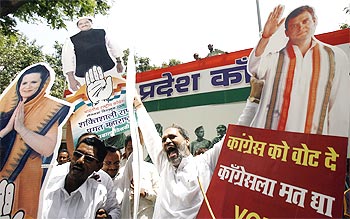

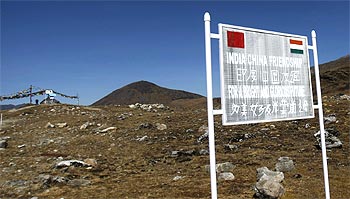
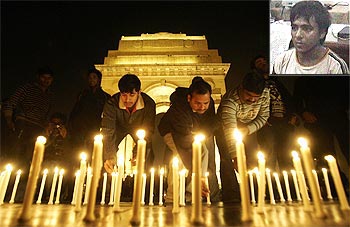
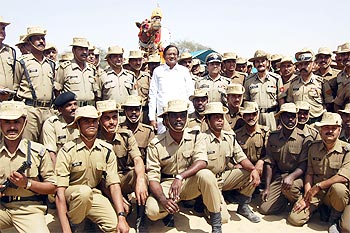


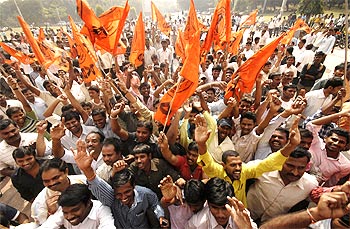
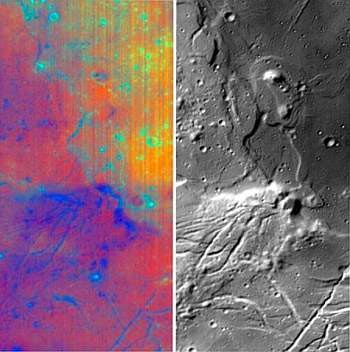
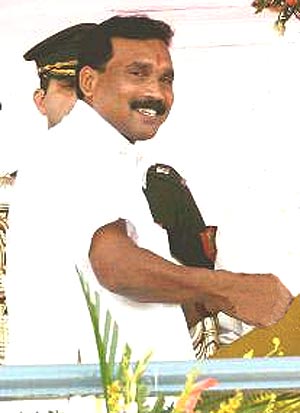
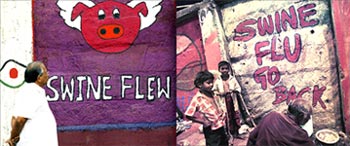
article